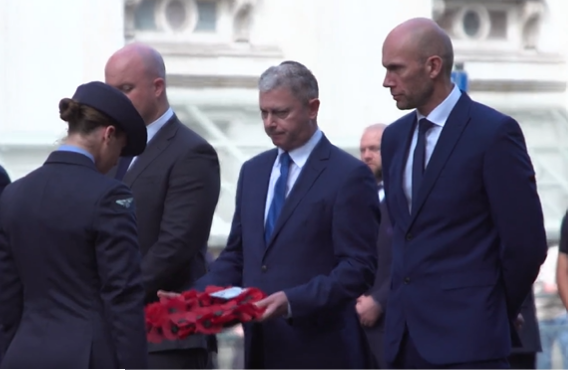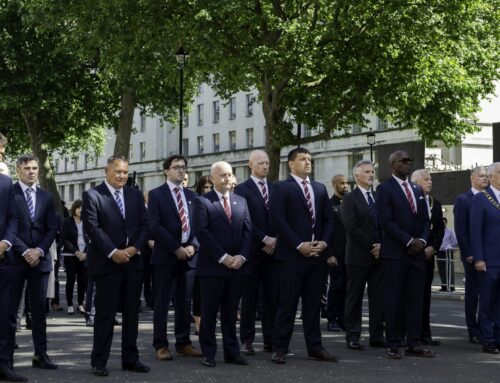 Rugby League Honours Those It Has Lost
Rugby League Honours Those It Has Lost
You first notice the silence. Walking down the middle of Whitehall, (since the road has been closed to traffic a few minutes before), there is no traffic and as a result there is no noise. Standing by the Cenotaph, Central London is eerily quiet. You can hear the birds chirping in the gardens of Downing St and on the trees along Whitehall. You can hear the aeroplanes coming in South of the river on their final approach to Heathrow. And you can clearly hear the chimes of Big Ben.
And when Big Ben starts to chime at 11:00, a smartly dressed Military Bugler sounds the Last Post.
The Last Post always triggers an emotional response in me. The piercing sound of the bugle seems to fill the entire air around the Cenotaph and along the route of Whitehall from Horse Guards Parade to the Houses of Parliament. Four Royal British Legion Volunteers slowly lower their flags. And as the final plaintive notes sound, tears well in the corner of my eyes. It is the same every year.
I am standing at the Cenotaph on Whitehall in Central London for the Rugby Football League ‘s annual Ceremony of Remembrance, which takes place the day before the Challenge Cup Final. This tradition has existed since the 1930s, and was happily reinstated in 2014, after some years of absence, such that it is now a regular fixture in the Rugby League calendar.
Rugby League is the only sport that holds a formal Ceremony of Remembrance at the Cenotaph on the day before its flagship event. No other sport does this. One might have thought that football, with its stranglehold on the national consciousness, might have a similar ceremony. But it is only Rugby League that does this and as a result it is hard to imagine that another sport would now try and start such a tradition. It is unique to Rugby League and I suspect that it will remain so.
Rugby league values its heritage. Heritage and history play a major part both in the narrative around the sport of rugby league and in the values and the culture that the sport represents. We take the opportunity, on what should be the most joyful of weekends, to pause and reflect and remember those from the Rugby League communities that gave their lives defending this country and its freedoms in the two World Wars and in subsequent conflicts. The Rugby League club, its volunteers, players and supporters, has always been closely woven into the community of the towns that they represent. When the Rugby League players who, at the time of the world wars, were big local stars lost their lives in conflict, it was a major trauma for the towns and cities and the clubs to which they had belonged. Rugby League therefore made it a tradition that they would pause to remember those who had made the ultimate sacrifice.
The format of the Remembrance Ceremony is that the Chair of the Rugby Football League, together with the Chair, Coach and Captain of the competing teams from the Men’s Challenge Cup, the Women’s Challenge Cup and the 1895 Cup, all lay a memorial wreath remembering those from their communities that have lost their lives. Wreaths are also laid by the All Party Parliamentary Group for Rugby League, this year represented by the RFL President, the Speaker of the House of Commons, together with representatives of the Royal British Legion, and the Armed Forces Rugby League club.
The whole initiative was given a fresh lease of life in 2014 thanks to the drive energy and determination of Squadron Leader Damien Clayton, of the Armed Forces Rugby League. He liaised with the parliamentary authorities, with the Royal British Legion and with the Ministry of Defence to enable the RFL to reinstate its long tradition of laying a wreath at the Cenotaph. It was he who liaised with the police and the security services to ensure that Whitehall was closed to traffic, so that the ceremony could take place with appropriate decorum and quiet, and allowing many many fans of Rugby League and curious spectators to observe the ceremony. The stand protesting in support of Julian Assange was even persuaded to stop its loud music for the duration of the ceremony.
After the Last Post, the eerie silence continues. You can hear clearly the clip of the shined boots of the Armed Service Personnel who bring the appropriate wreath to the appropriate delegation for them to lay it at Cenotaph. The Armed Services personnel hands the wreath, steps back, and either bows their head or delivers a crisp salute if they are handing it to a Military Officer. We then follow our instructions. We walk forward to the base of the Cenotaph, and the leader of the delegation, which in my capacity as chair of the RFL was me, dresses forward (using the appropriate military expression), lays the wreath and then steps back. All members of the delegation bow their heads in silent contemplation, then perform an “about turn” and return to their place.
There is a 2 minutes Silence. Then a Padre invites the delegates to join him in prayer, which is followed by a final Rouse from the Bugler and the ceremony is over. It lasts about 15 minutes. For the duration of the wreath laying, there is absolute silence. All one hears is the clip of the boots, the shoes of the delegations and the birds and the aeroplanes.
I am immensely proud at times like this to be Chair of the Rugby Football League. For our sport to so visibly recognise the sacrifice of those who have come before us is something that we should all be proud of. It is a ceremony that carries its own dignity and its own place in the life of the capital city.
The feeling of all those who participate in the ceremony – particularly the Chairs, the Coaches the Captains , the players is one of awe. They shake their head in wonder that our sport is afforded the opportunity to put on such a solemn ceremony. It is the best of Rugby league and long may it continue.



